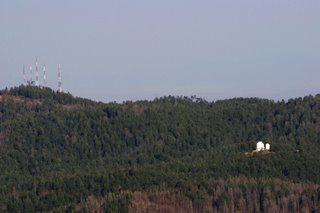
Just before twilight broke this morning, I pointed my camera towards the center of the Milky Way, rising above the Schmidt dome to the southeast. Scorpius (not Scorpio, that's astrology) is seen standing on it's tail on the right side of the image while the teapot shape of Sagittarius can be seen just below and to the right of the dome. The bright star fields are reminiscent of steam coming from the teapot's spout. Spectacular views like this used to be visible to everyone on a dark night, but since we insist on lighting up the night sky for no reason at all, at a cost of billions of dollars annually in the U.S. alone, this beautiful, natural light show is lost for just about everyone now. Canon 20D, 20 seconds, 20mm @ f/2.0, ISO 800
 Yesterday's image was taken at the base of the 61" dome facing southeast. This shot, taken just minutes later shows the 61" dome along with the Big Dipper as if it were pouring it's contents into the open slit. Polaris, or the North Star, is the bright star directly over the dome. Part of the glow in the lower left is light pollution from Phoenix, 100 miles away. Canon 20D - 20 seconds, 20mm @ f/2.0, ISO 800
Yesterday's image was taken at the base of the 61" dome facing southeast. This shot, taken just minutes later shows the 61" dome along with the Big Dipper as if it were pouring it's contents into the open slit. Polaris, or the North Star, is the bright star directly over the dome. Part of the glow in the lower left is light pollution from Phoenix, 100 miles away. Canon 20D - 20 seconds, 20mm @ f/2.0, ISO 800




















